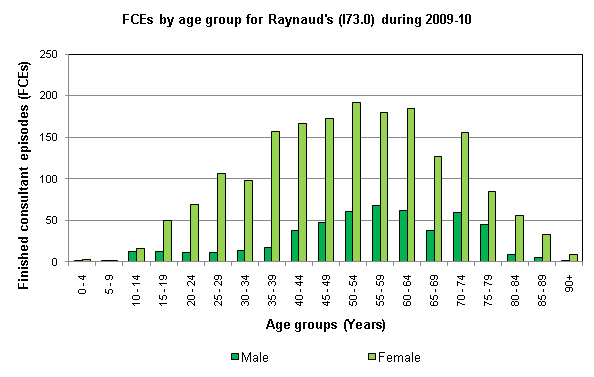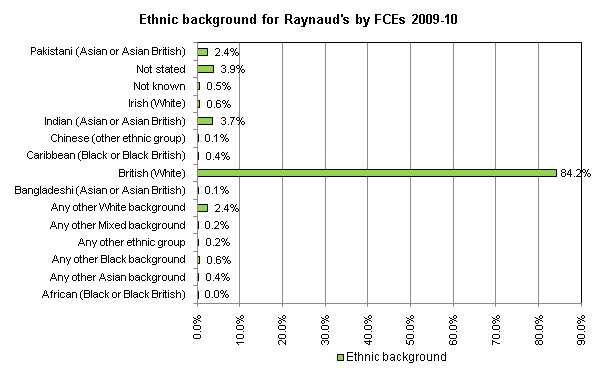IN THIS SITE...

- NHS Choices: Raynaud's
- Raynaud's & Scleroderma Association
- Inpatient data
- Self Service
HES on... Raynaud's
What is Raynaud's?
According to NHS Choices the condition occurs because your blood vessels go into a temporary spasm which blocks the flow of blood. This causes the affected area to change colour to white, then blue and then finally red as the blood flow returns.
Who does it affect?
According to NHS Choices Raynaud's is thought to affect up to 10 million people in the UK. Only a small proportion of those affected will be admitted to hospital.
Raynaud's is more common in women than men, and can affect people of all age groups (as shown by HES data in the graph below).
 |
HES facts and figures
HES data for Raynaud's (diagnosis code I73.0 in ICD-10) show that:
- more than a third 810 (35.5%) of hospital admissions for Raynaud's are from waiting lists
- the average (mean) time that patients remained in hospital was 4.8 days
- the most common procedures carried out on patients treated in hospital with Raynaud's was continuous infusion of therapeutic substance (X29 in OPCS-4.5) at 223 (9.4%) and (High cost hypertension drugs (X82 in OPCS-4.5) at 1,583 (66.5%):
- it was responsible for 2,381 episodes of hospital treatment, accounting for 4,682 FCE bed days
- 1,866 (78.3 %) of FCEs were for women
- 1,318 FCEs were day cases.
- the ethnic background also shows interesting results as White British makes up 2,005 (84.2%) of the 2,381 FCEs for Reynaud's in 2009-10 (as shown by HES data in the graph below).
 |
More information on this topic is available from NHS Choices here.
Footnote
A finished consultant episode (FCE) is a continuous period of admitted patient care under one consultant within one healthcare provider. FCEs are counted against the year in which they end. Figures do not represent the number of different patients, as a person may have more than one episode of care within the same stay in hospital or in different stays in the same year.

